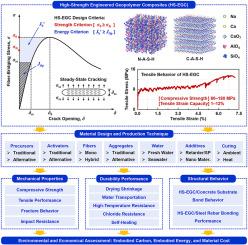Recent advances in High-Strength Engineered Geopolymer Composites (HS-EGC): Bridging sustainable construction and resilient infrastructure
IF 13.1
1区 工程技术
Q1 CONSTRUCTION & BUILDING TECHNOLOGY
引用次数: 0
Abstract
High-Strength Engineered Geopolymer Composites (HS-EGC) have emerged as a promising eco-friendly alternative to traditional High-Strength Engineered Cementitious Composites (HS-ECC) for sustainable infrastructure. For the first time, this review systematically summarizes the recent advances in HS-EGC technology, with a particular focus on successful cases achieving compressive strength over 80 MPa. Key parameters, including precursors, activators, aggregates, fibers, water content, additives, and curing conditions, are critically analyzed. In addition to technical parameters, mechanical properties, durability, structural performances, and sustainability of HS-EGC are also reviewed. While HS-EGC exhibited superior tensile ductility and durability alongside improved sustainability through industrial waste utilization, challenges remain regarding activator-related emissions, cost barriers, and scalability. This review provides practical guidance and research recommendations to support the optimized design and broader applications of HS-EGC in resilient infrastructure and sustainable construction.

高强工程地聚合物复合材料(HS-EGC)的最新进展:桥梁可持续建设和弹性基础设施
高强度工程地聚合物复合材料(HS-EGC)已成为传统高强度工程水泥复合材料(HS-ECC)的一种有前途的环保替代品,可用于可持续基础设施。本文首次系统总结了HS-EGC的最新进展,重点介绍了抗压强度超过80 MPa的成功案例。关键参数包括前驱体、活化剂、集料、纤维、含水量、添加剂和固化条件进行了严格的分析。除了技术参数外,还介绍了HS-EGC的力学性能、耐久性、结构性能和可持续性。虽然HS-EGC表现出优异的拉伸延展性和耐久性,并通过工业废物的利用提高了可持续性,但活化剂相关的排放、成本障碍和可扩展性仍然存在挑战。本文综述为支持HS-EGC在弹性低碳建筑中的优化设计和广泛应用提供了实践指导和研究建议。
本文章由计算机程序翻译,如有差异,请以英文原文为准。
求助全文
约1分钟内获得全文
求助全文
来源期刊

Cement & concrete composites
工程技术-材料科学:复合
CiteScore
18.70
自引率
11.40%
发文量
459
审稿时长
65 days
期刊介绍:
Cement & concrete composites focuses on advancements in cement-concrete composite technology and the production, use, and performance of cement-based construction materials. It covers a wide range of materials, including fiber-reinforced composites, polymer composites, ferrocement, and those incorporating special aggregates or waste materials. Major themes include microstructure, material properties, testing, durability, mechanics, modeling, design, fabrication, and practical applications. The journal welcomes papers on structural behavior, field studies, repair and maintenance, serviceability, and sustainability. It aims to enhance understanding, provide a platform for unconventional materials, promote low-cost energy-saving materials, and bridge the gap between materials science, engineering, and construction. Special issues on emerging topics are also published to encourage collaboration between materials scientists, engineers, designers, and fabricators.
 求助内容:
求助内容: 应助结果提醒方式:
应助结果提醒方式:


